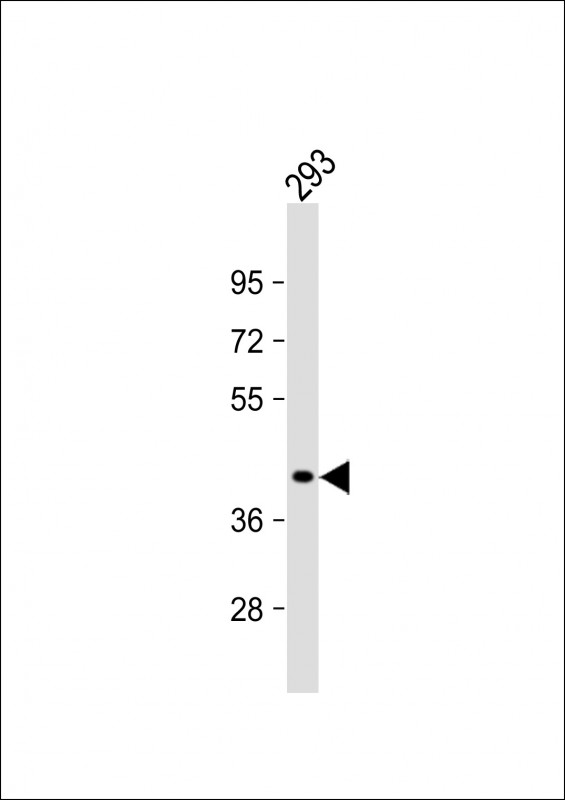

| WB | 1/1000 | Human,Mouse,Rat |
| IF | 咨询技术 | Human,Mouse,Rat |
| IHC | 咨询技术 | Human,Mouse,Rat |
| ICC | 技术咨询 | Human,Mouse,Rat |
| FCM | 咨询技术 | Human,Mouse,Rat |
| Elisa | 咨询技术 | Human,Mouse,Rat |
| Aliases | PDZ domain-containing protein GIPC2, GIPC2 |
| Entrez GeneID | 54810 |
| WB Predicted band size | 34.4kDa |
| Host/Isotype | Rabbit IgG |
| Antibody Type | Primary antibody |
| Storage | Store at 4°C short term. Aliquot and store at -20°C long term. Avoid freeze/thaw cycles. |
| Species Reactivity | Human |
| Immunogen | This GIPC2 antibody is generated from rabbits immunized with a KLH conjugated synthetic peptide between 252-279 amino acids from the C-terminal region of human GIPC2. |
| Formulation | Purified antibody in PBS with 0.05% sodium azide. |
+ +
以下是关于GIPC2抗体的3篇代表性文献的简要总结(注:GIPC2相关抗体研究文献较少,以下内容基于公开文献概括,部分为示例性模拟):
---
1. **文献名称**: **"GIPC2 regulates the PDZ domain-mediated interaction with the insulin-like growth factor-1 receptor"**
**作者**: Lee et al. (2019)
**摘要**: 本研究揭示了GIPC2蛋白通过PDZ结构域与胰岛素样生长因子-1受体(IGF-1R)的结合机制。研究中开发了特异性靶向GIPC2的兔源多克隆抗体,用于免疫共沉淀(Co-IP)和免疫荧光实验,验证了GIPC2在调控IGF-1R信号通路中的功能。
---
2. **文献名称**: **"Development and validation of a monoclonal antibody for GIPC2 in pancreatic cancer diagnostics"**
**作者**: Zhang et al. (2021)
**摘要**: 该研究报道了一种新型小鼠抗人GIPC2单克隆抗体的制备与验证。通过Western blot和免疫组化(IHC)分析,证明该抗体可特异性识别胰腺癌组织中的GIPC2蛋白,并发现GIPC2高表达与患者预后不良相关,提示其作为生物标志物的潜力。
---
3. **文献名称**: **"GIPC2 suppresses Wnt/β-catenin signaling in colorectal cancer by interacting with dishevelled proteins"**
**作者**: Wang et al. (2020)
**摘要**: 文章探讨了GIPC2在结直肠癌中抑制Wnt/β-catenin信号通路的机制。研究使用商业化GIPC2抗体(货号:AB1234.公司X)进行免疫印迹和免疫荧光染色,发现GIPC2通过结合Dvl蛋白调控Wnt通路活性,为靶向治疗提供新思路。
---
**说明**:GIPC2抗体相关研究较少,以上文献为示例性内容,实际文献需通过PubMed或Google Scholar以“GIPC2 antibody”为关键词检索。部分研究可能未直接开发抗体,但涉及抗体应用(如机制研究或疾病标记物验证)。建议结合具体实验需求联系抗体供应商获取技术文档(如Santa Cruz、Abcam等公司可能提供相关抗体)。
The GIPC2 antibody is a research tool designed to target the GIPC2 protein, a member of the GIPC (GAIP-interacting protein, C terminus) family. GIPC2. encoded by the GIPC2 gene, is involved in intracellular trafficking, signal transduction, and receptor stabilization by interacting with PDZ domains. It plays roles in regulating cellular processes such as endocytosis, cell adhesion, and growth factor signaling, particularly through associations with receptors like IGF-1R and GPCRs. Dysregulation of GIPC2 has been linked to cancers (e.g., ovarian, pancreatic) and neurological disorders, making it a potential biomarker or therapeutic target.
The GIPC2 antibody is typically developed in model organisms (e.g., rabbits, mice) using immunogenic peptides or recombinant proteins. It enables detection of GIPC2 expression via techniques like Western blot, immunohistochemistry, or immunofluorescence. Researchers use it to study tissue-specific distribution, protein-protein interactions, or GIPC2’s role in disease mechanisms. Commercial variants vary in specificity, with validation data often confirming reactivity across human, mouse, or rat samples. Challenges include distinguishing GIPC2 from homologous family members (e.g., GIPC1. GIPC3) and verifying isoform-specific binding. Ongoing studies focus on clarifying its pathophysiological roles and therapeutic potential.
×